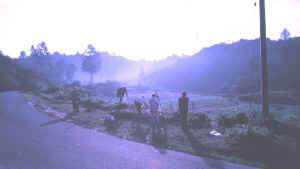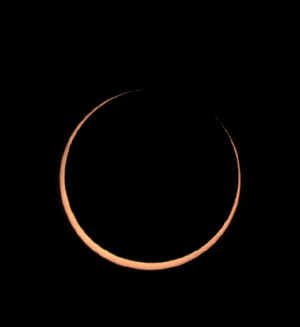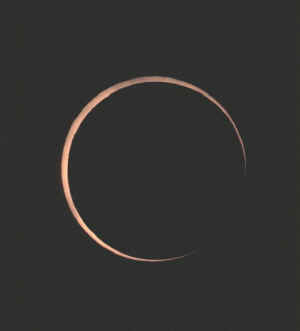 |
The observing site by the side of the road just outside Tarutung |
 |
Second contact |
 |
Mid-eclipse |
 |
Just after third contact |
Mike Harlow
In August 1998, two members of OASI went to Indonesia with a small group of geologists and astronomers to observe an annular solar eclipse. During our time there we were also lucky enough to visit Bosscha observatory near Bandung in West Java.
The Solar Eclipse
The eclipse itself started just before sunrise at about 6.10 am. This meant we had to make a very early start from our hotel at Prapat on the north eastern shore of Lake Toba. We left at 2.30 am for the three hour drive to the observing site. It was cloudy when we left and it soon started to drizzle and in fact for 2½ of the 3 hours the sky was completely overcast. Fortunately stars began to appear as we approached our eclipse site and when we arrived the sky was almost completely clear.
Our local guide had chosen the observing site in advance. Unfortunately, he obviously hadn't dealt with eclipse chasers before, as the site was simply too small and had a poor view of the sky. As a result we continued along the road searching for a better site. By chance we came to a narrow, winding road which lead up to a microwave transmitter. Ideal we thought, the transmitter must be at the top of a hill with excellent views! As we ascended the sky began to brighten as dawn approached but after a hair-raising drive we found the easterly view blocked by trees surrounding the transmitter station. After a brief discussion we decided to head back downhill as rapidly as possible and continue searching. By now the sun had risen, and the partial eclipse started, although we couldn't see it behind the tree lined hills.
We soon came across an excellent observing site about five kilometres south west of Tarutung, Sumatra, on the road to Sibolga, at approximately 2° 00'N 98° 54'E. We hurriedly set up our equipment at the side of the road just as the partially eclipsed sun rose over trees on a distant ridge.
As we were only two degrees north of the equator the sun rose almost vertically so it soon cleared the ridge. During the eclipse the motion of the moon carried it straight down across the solar disc. It soon became clear that the moon was smaller than the sun and half way through the partial phase the crescent sun started to extend more than half way round the moon. This was quite different from the total eclipse we saw in February 1998 where the crescent began to shrink as totality approached.
For several minutes before second contact we saw Bailey's beads at the cusps of the crescent sun. Unlike a total eclipse however they were not dazzling points of light seen against the corona but were just detached parts of the photosphere visible through the dense filters we were using.
Second contact arrived and the Moon became completely enveloped by the sun at around 7.15am. Although this eclipse covered just over 97% of the sun the sky and landscape were still brightly lit by the remaining 3%, again strikingly different from a total eclipse.
I don't think any of us timed the annular phase but it was predicted to last for just over two minutes. In common with a total eclipse however this time rushed past as the moon slid across the Sun's disc. By this time the Sun was over 15 degrees high in a clear patch of sky. The hill top where we would have been at the microwave station was completely covered in cloud at the time so it was lucky we didn't stop there!
There were only ten people in our group but there was a broad range of eclipse experience. Mike and Wendy Maunder were the most experienced observers and Mike observed and imaged the eclipse with a specially made refractor on a driven equatorial mount. Mike also used a wide field camera to take a sequence of shots of the partial and annular phases on a single frame. Several of us used telephoto lenses between 400 and 1000mm focal length, binoculars for visual observing and eclipse glasses made from Mylar or fully darkened black and white negative film. Of course all the cameras and binoculars were used with either Mylar or metal on glass high density filters for safe viewing throughout the eclipse.
The eclipse was a great success being visible in a clear sky with only slight interference from some high cloud. We were slightly north of the centre line so that the moon at mid-eclipse was not quite central on the disc of the Sun.
 |
The observing site by the side of the road just outside Tarutung |
 |
Second contact |
 |
Mid-eclipse |
 |
Just after third contact |
Who Else Saw the Eclipse?
Eclipse reports are co-ordinated by Jay Pasachoff of Williams College in the USA and since we returned from Indonesia a number of reports have appeared on his internet pages of other groups who observed the eclipse. It would appear that only a few groups travelled to see this eclipse. Our group was furthest west and hence the first in the world to experience 2nd contact and annularity. The others were in Malaysia, north of Singapore.
Jay Pasachoff and his group were in Mersing, Malaysia and had relatively good weather conditions, and a Japanese group were on Pulau Dayang, a small island near Mersing. An IOTA expedition was near Kota Tinggi on the southern edge of the eclipse path. They were interested in measuring the position of the eclipse path to test for changes in the Sun's diameter over time. They suffered much cloudier skies.
Visit to Bosscha Observatory, West Java
In 1994, out of the blue, I received a letter from the director of Bosscha Observatory in Java. It was a simple request for a copy of a telescope making article I had written which wasn't available through their library. I sent the article and didn't think any more of it. Four years later, having booked our trip to the Sumatra annular eclipse, we discovered that a visit to Bosscha Observatory was on the itinerary!
After a night's rest in a hotel in Bandung, where we experienced a minor earthquake(!), we headed off to the observatory. The observatory is situated on a hill in Lembang just a few miles north of Bandung, West Java, at 6° 57'S 107° 34'E. The observatory was founded in 1923 using money donated by K A R Bosscha, a German who had made his fortune from tea plantations in Java. The date of foundation puts the observatory just slightly younger than Cape Observatory, South Africa, the oldest observatory in the southern hemisphere. The observatory buildings are surrounded by tropical plants and flowers as well as fearsome looking yellow and black spiders. Their webs can be seen draped between the trees and bushes...not a place to walk around in the dark!
The host for our visit, Dr Bambang Hidayat, was extremely hospitable and made us feel like visiting royalty. The director of the observatory, many of his staff and students welcomed us with tea and cakes on the lawn outside the director's house. Local and national press interviewed our tour leader, Dr Peter Cattermole, and an article appeared in the newspapers the following day. Dr Hidayat arranged for us to be shown around the observatory and its several telescopes.
The largest instrument in the observatory is a double refractor completed in 1928 with each telescope having a 60cm Carl Zeiss lens of 11 meters focal length. Mounted together in a single tube they are held in an English type yoke mount. As the observatory is only 7°S of the equator the mount is at a very odd angle with the polar axis appearing almost horizontal! The telescopes are used for double star work and high resolution photography of clusters.
There are a number of run-off roof type buildings housing smaller instruments one of which is a 45cm Cassegrain built in Japan and given to the observatory as part of the Indo-Japan project. It is used for photometry of close binaries and spectroscopy.
The last of the three instruments we were shown was the 51cm Schmidt camera which was inaugurated on 28 May 1960. The corrector and the 70cm primary mirror, made at Yerkes Observatory in Chicago, combine to give an f/3.5 instrument that can cover a five degree field on 11cm square glass plates. The camera is used for studies of the structure of the Milky way. One student I spoke to was using the camera to measure the rotation curve of our galaxy by taking images using a 6° objective prism giving 312Å/mm dispersion. The spectra of the stars can be used to work out their velocities around the galactic centre.
The observatory is close to Bandung, with a population of 2½ million people, and this means that light pollution is becoming a problem. However, the astronomers carefully define their observing programs and this enables them to make good use of the average 200 clear nights per year. The observing programs include double stars and cluster studies.
Reference
Details of Bosscha Observatory and its history are adapted from Astronomy in Indonesia by B. Hidayat, J. Korean Ast. Soc., Vol 29, S455-457, 1996.
Related Information
Prospects for future solar eclipses
See also Fred Espenak's eclipse web site at sunearth.gsfc.nasa.gov/eclipse/eclipse.html